Curiosity’s 7 minutes of terror
Time to touchdown
Altitude
Velocity
Guided entry
Just before entering the atmosphere, the spacecraft sheds two 75-kilogram tungsten weights, shifting its centre of mass and creating a crude ability to generate lift. "We're flying a brick," says Allen Chen, the JPL's operations lead for entry, descent and landing. The ability to change the lift vector lets the spacecraft compensate for unexpected fluctuations in atmospheric density, reducing the size of the potential landing area and making it possible to land in Gale Crater. All the manoeuvres have to be done by dead reckoning, using the spacecraft's internal gyroscopes.
T–6 min 43 s
125 km
5,900 m s-1
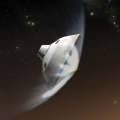
Peak heating
Lightweight carbon tiles, similar to those on NASA's 1999 Stardust comet-sample-return mission, protect the spacecraft from steel-melting temperatures of up to 2,100 °C.
T–5 min 28 s
Peak deceleration
All parts of the spacecraft had to be designed to withstand accelerations 15 times as strong as Earth's gravity.
T–5 min 18 s
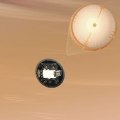
Parachute deployment
The parachute, nearly 16 metres in diameter, is expelled by a mortar blast. Of the 1.7% overall risk of failure, about 1% is due to potential problems with the parachute, such as tangled lines or turbulent oscillations. The parachute design strays little from that used in the successful Viking landings, but there have been only limited tests at the speeds and densities that the parachute will experience in the Martian atmosphere — just a few drops from balloons in Earth's stratosphere during the 1970s.
T–2 min 28 s
11 km
405 m s-1
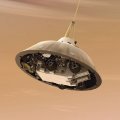
Heat shield separation
After the heat shield is expelled, six radar antennas turn on. They have a field of view of 3 degrees each, and provide the first independent check on the internal estimate of the spacecraft's altitude. "We finally get eyes, and it's absolutely vital," says Steven Lee, Curiosity's guidance, navigation and control-systems manager. To test the system, engineers strapped the antennas to an FA-18 fighter jet and flew it at the ground.
T–2 min 4 s
8 km
125 m s-1
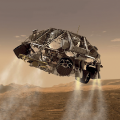
Back-shell separation
The parachute is jettisoned, along with the back shell, and eight retrorockets — similar to those used by Viking — begin to fire. They first jerk the spacecraft sideways by 300 metres to get it out of the way of the parachute. "If we didn't do that we'd get hit in the back of the head," says Steve Sell, deputy operations lead for entry, descent and landing at the JPL.
T–53 s
1.6 km
80 m s-1
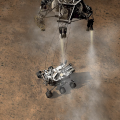
Sky crane
Previous landings have used airbags to cushion the final part of the fall. But Curiosity is too heavy, so engineers arranged to use the rover's wheel-suspension system as landing gear. A bridle made of three nylon cords and an 'umbilical cord' for data unspools, dropping the rover 7.5 metres beneath the descent stage, which is still descending under the power of four retrorockets.
T–13 s
20 m
0.75 m s-1
Touchdown
Once the rover stops moving, the bridle cords are severed and the descent stage flies away to land at least 150 metres from the rover. The final touchdown is the second-riskiest part of the landing, after the parachute deployment. The 0.7% risk is divided between different terrain hazards. Rocks and slopes could in rare cases flip the rover over, or Curiosity could land in a crater too deep to escape or on a mesa too steep to descend.
T–0:00
Source: NASA/JPL-Caltech; Illustration: J. Krzysztofiak


Social Media Box - AML